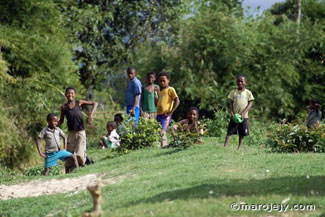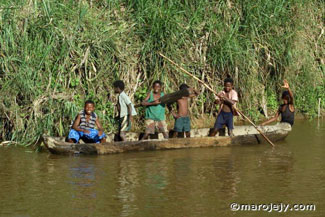 |
|||||
|
Why a page on children? Because they are the Madagascar of tomorrow, on which everything depends. They are the smiles that brighten the days, the innocence that splashes in the puddles and plays games in the streets. Children reflect the story of Madagascar and they represent the way to come. On them rests the burden of the better days so hoped for. In Madagascar, children less than fifteen years of age make up nearly fifty percent of the population. Energetic, happy-go-lucky, always full of curiosity, sometimes fearful of strange visitors, hiding behind their parents, their big brothers… And now and then turning to mischief and malice… In Andapa, close to 5,000 children attend school in both public and private institutions. Public schools include elementary (EPP), middle (CEG) and high schools (lycée mixte). Many private schools of different academic levels are run by religious organisations, including the Catholic, Protestant and Adventist churches.
While more children are now being educated due to a large increase in the number of schools (promoted by the President of the Republic), there still is a great need for more qualified teachers and better teacher training. The organization Alliance Française of Andapa has been able to assist in this respect by offering courses for schoolteachers. The Madagascar Action Plan (MAP), a long-term plan aimed at reducing poverty and enhancing the quality of life for the Malagasy people, specifically targets improvements in education, and gives hope that things will improve. The quality of education provided in the country for the next 25 years will certainly be a key factor if Madagascar is to take a place amongst the elite of the emerging nations. This is an enormous challenge, as much in human terms as financial or material, but it is unquestionably the launching pad toward a more prosperous future for a country which has too long suffered. For many visitors, the cries of "bonjour, vazaha!" (hello, foreigner) and "salut, copain!" (hi, friend) will be forever engraved in their memories – along, perhaps, with the images of children streaming out of villages in greeting, full of exuberance and curiosity at seeing new faces. From these spontaneous and joyous moments come the most lasting bonds and the best memories.
Regarding gifts, the best advice we can give to visitors is to never give anything directly to children. Gifts of pens, tee-shirts and candy might delight the child to whom it is given, but all too often it creates jealousies and hard feelings amongst peers. Noisy scuffles between children over the powder of cookies crushed by grabbing hands is an unpleasant memory taken home by too many visitors. So what to do? First, remember that your smiles and friendship are gifts in themselves, and are all that are necessary. If, however, you wish to give something more, give it to a responsible adult (for example, a schoolteacher) in front of several witnesses, to be distributed equitably amongst the children. Coloured pencils, colouring books, and school materials are useful items that will not rot teeth. The younger generation is full of energy and vitality, but life here can be hard. It is not rare to see a four-year-old child, machete in hand, herding a couple of zebu cattle. If some children spend their days hammering rocks into gravel, and others don't go to school in order to work in the rice fields or on the burned hillsides, the local customs see to it that it is always done in a family setting, very different from our western standards. Nevertheless, one wishes all the best for the children of Andapa and Madagascar – with a bright future, full of hope.
|
||||


